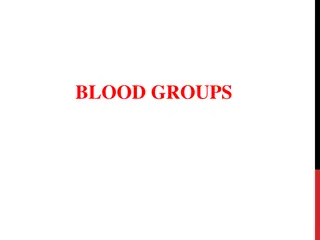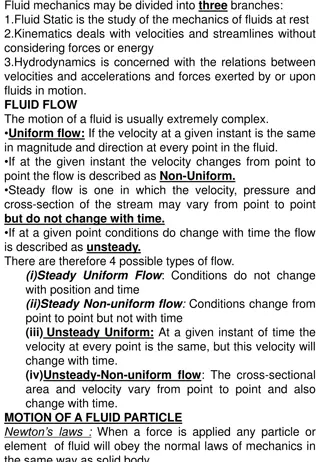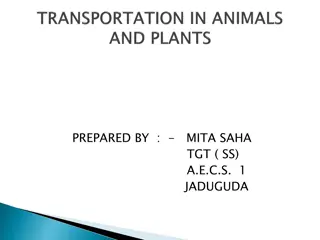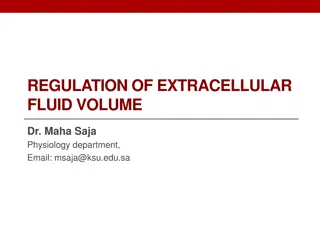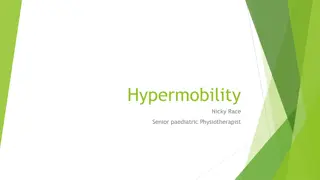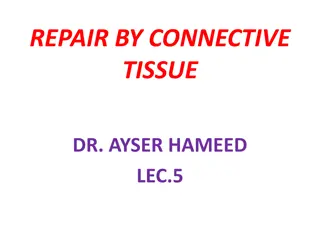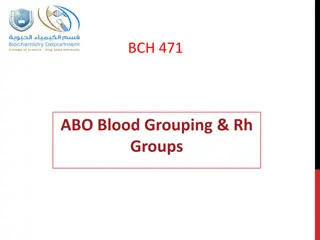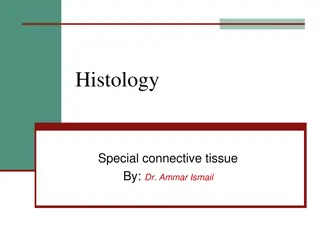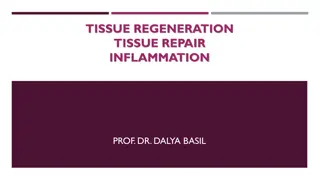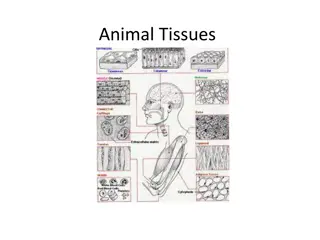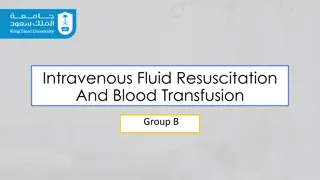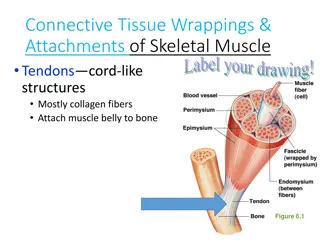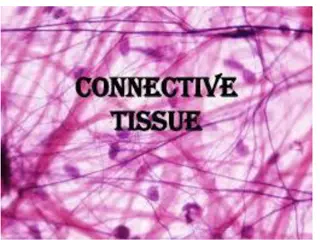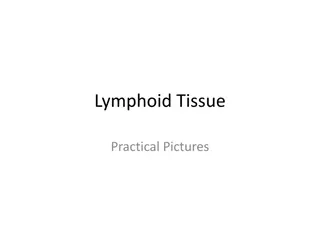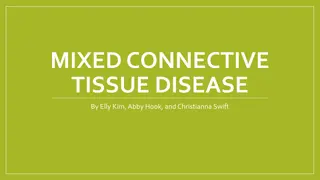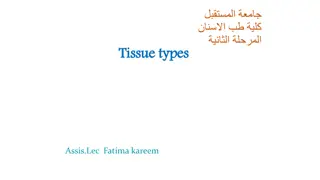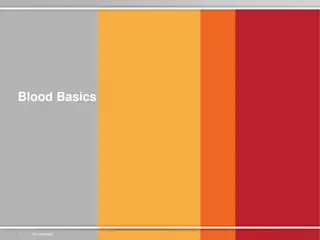Blood: The Vital Fluid Connective Tissue
Blood, the fluid connective tissue, plays a crucial role in transporting oxygen and carbon dioxide, maintaining pH balance, regulating body temperature, and more. It consists of formed elements such as red blood cells, white blood cells, and platelets, suspended in plasma. Understanding its functions and components is essential in the field of healthcare and medicine.
Download Presentation

Please find below an Image/Link to download the presentation.
The content on the website is provided AS IS for your information and personal use only. It may not be sold, licensed, or shared on other websites without obtaining consent from the author.If you encounter any issues during the download, it is possible that the publisher has removed the file from their server.
You are allowed to download the files provided on this website for personal or commercial use, subject to the condition that they are used lawfully. All files are the property of their respective owners.
The content on the website is provided AS IS for your information and personal use only. It may not be sold, licensed, or shared on other websites without obtaining consent from the author.
E N D
Presentation Transcript
Blood is the connective tissue in fluid form. It carries oxygen from lungs to all parts of the body & carbon dioxide from all parts of the body to the lungs. It is also called fluid of health.
1. COLOR 2. VOLUME 3. REACTION & PH 4. VISCOSITY
1. Nutrient function 2. Respiratory function 3. Excretory function 4. Transport of hormones & enzymes 5. Regulation of water balance 6. Regulation of acid base balance 7. Regulation of body temperature 8. Storage function 9. Defensive function
Blood cells formed elements Liquid portion plasma 1. BLOOD CELLS: -RBC -WBC -PLATELETS 2. PLASMA: -91-92% of water -8-9% solids {organic & inorganic substance}
Ways of obtaining blood: Capillary or Peripheral blood Venous blood Peripheral blood: For total and differential blood counts and for haemoglobin estimation Sites: Lobe of the ear Palmar surfaces of the tip of finger For infants: from the plantar surface of the heel and toe Venous blood For haematological exercises venous blood is better. Peripheral blood: Venous blood: :
- Erythrocytes - Red in colour due to presence of Hb - Vital role in transport of respiratory gases - Disk or biconcave in shape - Diameter 7.2 microns - Non nucleated, DNA, mitochondria, golgi- apparatus are absent. - Energy is produced from glycolytic process - They do not have insulin receptor so glucose uptake by this cell is not controlled by insulin. - Life span 120 days - RBC have special type of cytoskeleton which is made up of actin & spectrin.
Transport of oxygen from lungs to the tissues Transport of carbon dioxide from the tissues to the lungs Buffering action in blood Blood group determination
Rouleaux formation Sp. Gravity Suspension stability Packed cell volume or hematocrit
The rate at which the erythrocytes settle down is called ESR DETERMINED BY 1. WESTERGRENS METHOD 2. WINTROBES METHOD FACTORS AFFECTING ESR: 1. Sp gravity 2. Rouleaux formation 3. Increase in size of RBC 4. Viscosity 5. RBC count
PHYSIOLOGICAL VARIATIONS 1. Age 2. Sex 3. Menstruation 4. Pregnancy PATHOLOGICAL VARIATIONS 1. Tuberculosis 2. All type of anaemia { sickle cell anaemia} 3. Malignant tumour 4. Rheumatoid arthritis 5. Rheumatoid fever 6. Liver disease
ESR DECREASES IN 1. Allergic condition 2. Sickle cell anaemia 3. Peptone shock 4. Polycythemia 5. Extreme leukocytosis
Physiological variation: Increase polycythemia 1. Age 2. Sex 3. High altitude 4. Muscular exercise 5. Emotional condition 6. After meals Decrease: 1. High barometric pressure 2. During sleep 3. pregnancy
Primary polycythemia: - Polycythemic vera Secondary polycythemia: - Respiratory disorder like emphysema - Congenital heart disease - Ayerzas disease - Chronic carbon monoxide poisoning - Poisoning by chemicals like phosphorous & arsenic - Repeated mild haemorrhages
Morphological: 1. Normocytic normochromic 2. Macrocytic normochromic 3. Microcytic hypochromic PATHOPHYSIOLOGIC: 1. Anaemia due to increased blood loss a. Acute b. Chronic
2. Anaemia due to impaired red cell production a. Cytoplasmic maturation defects - iron def anaemia - thalassaemic syndromes b. Nuclear maturation defects - megaloblastic anaemia c. Defect in stem cell proliferation & differentiation - aplastic anaemia d. Anaemia of chronic disorders e. Bone marrow infiltration f. Congenital anaemia 3. Anaemia due to increased red cell destruction{haemolytic anaemia} a. Extrinsic b. intrinsic
1. Skin 2. Cvs 3. Respiration 4. Digestion 5. Metabolism 6. Kidney 7. Reproductive system 8. Neuromuscular system
Type of anaemia Type of anaemia causes causes Morphology of RBC Morphology of RBC 1. HAMORRHAGIC Acute loss of blood Normocytic, normochromic Microcytic, hypochromic Normocytic, normochromic Normocytic, normochromic Normocytic, normochromic Chronic loss of blood Liver failure 2. HEMOLYTIC ANAEMIA Renal disorder Hyper splenism Burns Normocytic, normochromic Congenital or acquired default in the shape of RBC Sickle cell anaemia sickle shape Thalassemia small, irregular shape Normocytic, normochromic 3. APLASTIC ANAEMIA Bone marrow disorder
TYPE OF ANAEMIA 4. Nutrition deficency anaemia TYPE OF ANAEMIA CAUSES Iron def CAUSES MORPHOLOGY OF RBC Microcytic, hypochromic Macrocytic, hypochromic Macrocytic, hypo/normochromic Megaloblastic, hypochromic Normocytic, normochromic Normocytic, normochromic MORPHOLOGY OF RBC Protein def Vitamin B12 def Folic acid def 5. Anaemia of chronic disease Non-infectious inflamatory disease Chronic infections
VARIATION IN SIZE OF RBC: 1. Microcytes decrease in size 2. Macrocytes increase in size 3. Anisiocytes cells with out uniform size VARIATION IN SHAPE OF RBC: 1. Crenation 2. Spherocytosis 3. Elliptocytosis 4. Sickle cell 5. poikilocytosis
Leukocytes are colourless & nucleus formed elements. Larger in size & lesser compared with RBC. Plays a defensive mechanism & protect the body from invading organism.
GRANULOCYTES 1. Neutrophils 50-70% 2. Eosinophils 2-4% 3. Basophils 0-1% AGRANULOCYTES 1. Monocytes 2-4% 2. Lymphocytes 20-30% - large lymphocytes 10-12 microns - small lymphocytes 7-10 microns
LIFE SPAN Depends of its body & function 1. Neutrophils 2-5 days 2. Eosinophils - 7-12 days 3. Basophils 12-15 days 4. Monocytes 2-5 days 5. Lymphocytes 1 day PROPERTIES 1. Diapedesis 2. Ameboid movement 3. Chemotaxis 4. phagocytosis
Total WBC count 4000-11000 cu mm of blood PHYSIOLOGICAL VARIATION 1. Sex 2. Diuranal variation 3. Exercise 4. Sleep 5. Emotional condition 6. Pregnancy 7. menstruation
PATHOLOGICAL VARIATION: Leukocytosis 1. Allergy 2. Infection 3. Common cold 4. Tuberculosis 5. Glandular fever
NEUTROPHILIA: 1. Acute infection 2. Metabolic disorders 3. Infection of foreign proteins 4. Injection of vaccine 5. After acute haemorrhage EOSINOPHILIA 1. Allergic condition 2. Asthma 3. Scarlet fever 4. Blood parasitism BASOPHILIA 1. Small pox 2. Chicken pox 3. Polycythemic vera
MONOCYTOSIS 1. Tyberculosis 2. Syphilis 3. Malaria 4. Kala-azar 5. Glandular fever LYMPHOCYTOSIS 1. Diphtheria 2. Mumps 3. Malnutrition 4. Rickets 5. Syphilis 6. Thyrotoxicosis 7. Infectious hepatitis
LEUKEMIA - Abnormal & uncontrolled increase in leukocyte count more than 100000 cu mm - Also called blood cancer LEUKOPENIA Decrease in WBC 1. Anaphylactic shock 2. Cirrhosis of liver 3. Disorder of spleen 4. Pernicious anaemia 5. Typhoid & para-typhoid 6. Viral infection
Are colourless , small , non nucleated & moderately refractive bodies. Diameter 2.5 microns Shape spherical or rod shape becomes oval or disc when inactivated Normal count 250000 cu mm of blood Life span 10 days Platelets are formed from bone marrow
STRUCTURE & COMPOSITION 1. Cell membrane - glycoproteins - phospholipids 2. Microtubules 3. Cytoplasm - proteins - enzymes - hormonal substance - other chemical substance PROPERTIES 1. Adhesiveness 2. Aggregation 3. agglutination
FUNCTION 1. Role in blood clotting 2. Role in clot retraction 3. Role in prevention of blood loss 4. Role in repair of ruptured blood vessel 5. Role in defence mechanism PHSIOLOGICAL VARIATION 1. Age 2. sex 3. High altitude 4. After meals
PATHOLOGICAL VARIATION Thrombocytopenia 1. Acute infection 2. Acute leukemia 3. Chicken pox 4. Splenomegaly 5. Thypoid 6. Tuberculosis 7. Purpura 8. Aplastic & pernicious anaemia THROMBOCYTHEMIA persistent & abnormal increase 1. Carcinoma 2. Chronic leukemia 3. Hodgkins disease
THROMBOCYTOSIS increase in platelet 1. Allergic condition 2. Asphyxia 3. Haemorrhage 4. Bone fracture 5. Surgical operation 6. Rheumatoid fever 7. Trauma
- Serum is different from plasma - It only contains albumin & globulin Thus serum = plasma fibrinogen NORMAL VALUES Total proteins 7.3 gm% Serum albumin 4.7 gm% Serum globulin 2.3 gm% Fibrinogen 0.3 gm% A/G ratio 2:1
PROPERTIES: 1. Molecular wt 2. Osmotic pressure 3. Sp. Gravity 4. Buffer action ORIGIN: Embryo mesenchyme cells Adults reticuloendothelial of liver, spleen, bone marrow & other tissue cells - Gamma globulin is synthesised from B- lympocytes
Role in coagulation of blood Role in defence mechanism of the body Role in transport mechanism Role in maintains of osmotic pressure in blood Role in regulation of acid base balance Role in viscosity of blood Role in ESR Role in reserve proteins Role in production of trephone substance 1. 2. 3. 4. 5. 6. 7. 8. 9. 10. Role in suspension stability of RBC
PLASMA PLASMA PROTEIN PROTEIN WHEN INCREASES WHEN INCREASES WHEN DECREASES WHEN DECREASES TOTAL PROTEINS Dehydration Diarrhea Haemolysis Haemorrhage Leukemia Burns Rhematoid arrthritis Pregnancy Alcoholism Mal nutrition ALBUMIN Dehydration Malnutrition Congenitive cardiac failure Cirrosis of liver Burns Hypothyroidism Excessive intake of water Emphysema GLOBULIN Cirrhosis of liver Chronic infection Hypogammaglobuline mia Acute hemolytic Nephrosis
PLASMA PROTEIN PLASMA PROTEIN WHEN INCREASES WHEN INCREASES WHEN DECREASES WHEN DECREASES FIBRINOGEN Acute infection Liver dysfunction Rhematoid arthritis Use of anabolic steroids Use of phenobarbital Stroke Trauma Myocardial infarction A/G RATIO Hypothyroidism Liver dysfunction Excess of glucocoticoids Intake of high carbohydrate & protein diet nephrosis hypogammaglobuline mia
Majority of the disease is directly or indirectly relate with the blood. So haematological investigation plays a vital role in conforming the diagnosis
ORAL MEDICINE - BURKETS 8THEDITION HUMAN PHSIOLOGY SEMBULINGAM ORAL MEDICINE - GARY C. COLEMAN J.F NELSON ORAL MEDICINE KERR ASH MILLER GENERAL PATHOLOGY HARSH MOHAN

 undefined
undefined








